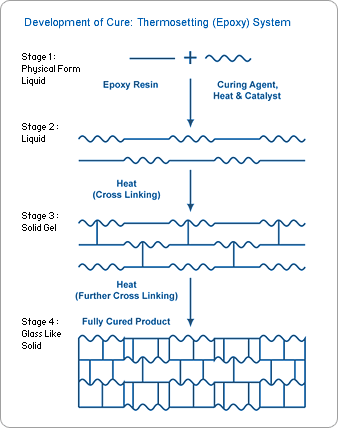Epoxy Resin Chemistry
By Durcon Technical Services
The curing of an epoxy resin system normally takes place in stages. The first of these is the combining of the two reactive materials - the epoxy resin and the curing agent. Normally, these two components are kept apart until reaction is desired. The resin is normally a viscous liquid and the curing agent may be a liquid or a low-melting solid.
When combined and a catalyst and heat are added, the resin and curing agent react with a release of additional heat. Reactive epoxy systems always release heat when curing, thus, they are classified as exothermic reactions. The exothermic heat acts to speed reaction. This second stage of reaction results in formation of linear chains of combined epoxy resin and curing agent. As the linear chains form, the material is still in a liquid form but viscosity is increasing rapidly.
Heat and catalyst promote further reaction. The linear polymer chains are combined through chemical reactions in a cross-linking process to form a polymerized system approaching an extremely high molecular weight. During this third stage of reaction, the material changes from a viscous liquid to a solid gel. In this stage, the material is developing strength. It is at this stage that, at LTI, the material is removed from the mold and placed in a cure oven. This material, just strong enough to be moved, is at a stage of incomplete cure, relatively weak and unsuitable for the intended use.
The final stage of curing, a lengthy process carried out at an elevated temperature at LTI, results in completion of the cross-linking process. The final product is a very strong, chemically resistant material which is suitable for a variety of applications.



Validate your login
Sign In
Create New Account